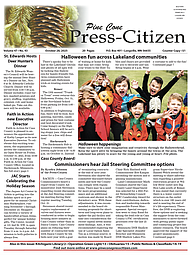June 10, 2021 at 1:12 p.m.
Hunting is about what we don't shoot, too
It would be dishonest to say that the kill is unimportant. Hunting is, in part, a reenactment of survival dramas that were an everyday experience for our not-so-distant ancestors. Today's hunter is not going to starve if he is unsuccessful, and he is not in danger of being eaten, unless he's hunting brown bears in Alaska, or lions in Africa. But the ritual of the hunt is a response to an instinct as old as our species, and is no less real just because our survival no longer depends on it.
Unlike our cave or log cabin-dwelling ancestors, for whom hunting was serious business, we have the luxury of being able to focus on, and better appreciate, the "play within the play," the things that happen at times other than when we are pulling the trigger on a favorite shotgun or rifle.
On my last duck hunt of the season, in mid-November, the shots at ducks were few and far between. That can be the case when there are very few other duck hunters to "keep them stirred up," at a time when many ducks have already passed through in migration, and when the birds have learned which waters are "refuge," and which are not!
It would be untrue to say we weren't disappointed at the slow, almost nonexistent shooting. But my hunting partner and I were also treated to some sights and sounds that are not everyday occurrences over the course of a duck season, and were no less special just because our shotguns were quiet.[[In-content Ad]]
One of the most memorable was to find ourselves in the midst of migration of tundra swans, and their larger relative, the trumpeter swan. Tundra swans nest, as their name implies, on the arctic tundra far to the north. Trumpeter swans, North America's largest waterfowl, nest from Alaska south through Minnesota. Trumpeters, in particular, have a haunting call that so eloquently says "wild."
During the market hunting period, trumpeters were hunted for their meat and feathers, and were eliminated from Minnesota by the 1880's. Starting with the 1979 release of young raised from eggs gathered in Alaska, resident trumpeters now number more than 5,000 in Minnesota. They are among the hardiest of waterfowl, and will stay as far north as open water on rivers and lakes permits.
If you follow "outdoorsy" things in the news media, every year it seems there will be an article describing the illegal shooting of one or more trumpeter or tundra swans. This year a pair of trumpeters was shot on a wildlife management area north of the Twin Cities. The two hunters "shot first and asked questions later," and were turned in through the Turn in Poachers (TIP) hotline, by nearby hunters; more power to them!
The pair could face fines and restitution costs totaling $1,700 each, an expensive lesson that neither is likely to forget. Only the most inexperienced waterfowl hunter would mistake one of these huge, all-white birds for a snow goose, which is the only waterfowl it comes close to resembling.
A trumpeter swan has a wingspan that can exceed seven feet, a tundra swan just slightly less, while a snow goose might have a wingspan less than half that, and a neck much shorter in proportion to its body. A greater snow goose might weigh as much as seven pounds, while tundra and trumpeter swans can tip the scales at as much 18 and 30 pounds, respectively. Snow geese have black wing tips, while these swans' plumage is pure white from stem to stern.
Hunting partner Jim and I not only saw dozens of these majestic birds at a distance, but had several small groups swing right over our duck decoys, whose white paint may have caught the swans' attention. Compared to ducks, they looked the size of bombers, their wedge-shaped black bills in sharp contrast to their crisp, "formalwear" white plumage. It would have been quite a sight to see a duck dog, in the market hunting era, trying to make a retrieve on a bird this size!
Our bag of ducks on this particular morning consisted of a pair of bluebills, and one regal drake canvasback, always a trophy to a duck hunter. But we considered those majestic swans winging over our decoys to be trophies, too. We'll remember the details of their passage as clearly as those ducks that splashed down into our decoys.
WEATHER SPONSORED BY
Latest News
Events
November
To Submit an Event Sign in first
Today's Events
No calendar events have been scheduled for today.

Comments:
You must login to comment.